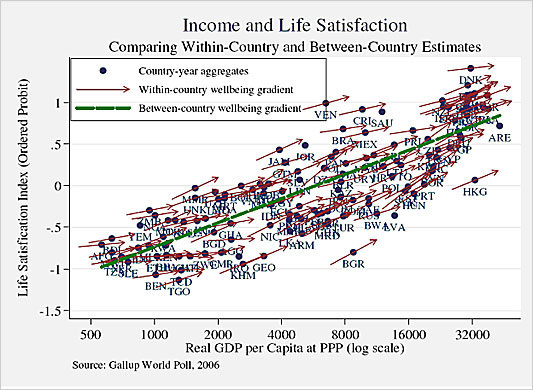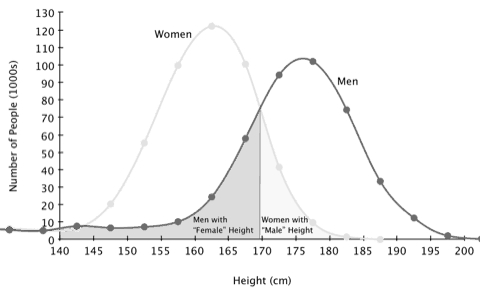|
Sometimes, facts rub people the wrong way. But that doesn't make them untrue. From genetics to psychology to economics to statistics, there are plenty of politically incorrect facts that many of us don't know -- and, in some cases, have even been made to believe the opposite.
But facts matter. Science matters. Research matters. History matters. And that is why I wanted to dive into some politically incorrect facts. Consider yourself warned.
1. Money makes people — and countries — happier.
There’s a common belief in popular psychology that, beyond a certain income level, money doesn’t make us happier. This myth exists because of bad statistics. Of course if you look at raises in income by an amount, rather than a percent, it doesn't make people happier. It's called “diminishing returns.” There's a lot you can buy with $22,000 that you couldn't buy with $20,000. But what can you buy with $102,000 that you couldn't buy with $100,000? Now, what can you buy with $120,000 that you couldn't buy with $100,000? In other words, if you look at increases as a percent, rather than an amount, the data tells a very different story. As I wrote in "The Great Affluence Fallacy" is a Great Big Lie: Wherever you live in the world, rich people are happier than poor people. Countries with higher GDPs are much happier than countries with lower ones: Rich countries are happier than poor countries… in roughly equal measure to rich people being happier than poor people within a society. I know these graphs are a lot to look at. If you need help interpreting them, read the full article, or check out The New Stylized Facts about Income and Subjective Well-Being, by Sacks, Stevenson and Wolfers, 2012. 2. Tall people make more money -- and Each Inch of Your Height is Worth $789 Per Year. Sometimes, beauty standards are cultural -- for example, men's facial hair is considered attractive in some cultures, but ugly in others. Sometimes, beauty standards are universal -- for example, the ideal waist:hip ratio in women seems to be 0.7 in every culture psychologists have studied, regardless of the women's BMI. Which makes sense. This ratio is determined by sex hormones, and the women who are the most fertile tend to have a waist that is about 70% as wide as their hips. Or, for another example: there is no culture, anywhere, where old women are considered more attractive than young women. This also makes sense. Men who were attracted to old women didn't have as many babies, giving men with a preference for younger, more fertile women a significant evolutionary advantage. Finally, there is no culture, anywhere, where short men are considered more attractive than tall men. In fact, being tall is correlated with higher earning potential for both genders. A 2015 study by Andreas Schick and Richard H. Steckel found that people in the 75th percentile of height made 9-15% more than people in the 25th percentile. Additionally, a 2004 study by psychologist Timothy A. Judge and Daniel M. Cable found that every inch of height amounts to a salary increase of about $789 per year (the study controlled for gender, weight and age). Meaning that, on average, someone who is 6'0 earns $5,525 more per year than someone who is 5'6. Which, compounded, adds up to hundreds of thousands of dollars over one's career.
The Returns on an Additional Inch, for Men. From The Financial Perks of Being Tall
Moreover, height seems to play a role in your likelihood to get promoted to leadership positions. As Malcolm Gladwell wrote in Blink: The Power of Thinking Without Thinking (a must-read for anyone who hasn't already read it): “The heads of big companies are, as I’m sure comes as no surprise to anyone, overwhelmingly white men, which undoubtedly reflects some kind of implicit bias. But they are also virtually all tall: In my sample, I found that on average CEOs were just a shade under six feet. Given that the average American male is 5’9″ that means that CEOs, as a group, have about three inches on the rest of their sex. But this statistic actually understates matters. In the U.S. population, about 14.5 percent of all men are six feet or over. Among CEOs of Fortune 500 companies, that number is 58 percent. Even more strikingly, in the general American population, 3.9 percent of adult men are 6’2″ or taller. Among my CEO sample, 30 percent were 6’2″ or taller.” Read more > Why might this be the case? Aside from physical attraction and perceptions of power, it could be related to the fact that: 3. Tall people are smarter than short people. Several studies have shown a statistically significant positive correlation between height and intelligence in human populations. (See also: Wilson DM, Hammer LD, Duncan PM et al. Growth and intellectual development; Walker SP, Grantham-McGregor SM, Powell CA, Chang SM. Effects of growth restriction in early childhood on growth, IQ, and cognition at age 11 to 12 years and the benefits of nutritional supplementation and psychosocial stimulation; Tanner JM. Relation of body size, intelligence test scores and social circumstances; etc.) Similar associations have been found in early and late childhood and adulthood in both developed and developing countries, even when controlling for socioeconomic status and parental education. (This obviously doesn't mean that short people can't be smart.) The reasons for this association are unclear, but possible explanations include:
It has also been suggested that large increases in height are associated with increases in brain size -- which may help explain the Flynn effect, or the fact that the average IQ seems to increase by three points per decade. But worry not! There is hope for the vertically challenged! 4. Achievement isn't normal. It's log-normal. Let me start by saying that, despite what my Halloween costume might have suggested, it is not a microaggression to say, "I believe that with hard work, anyone can succeed." But... it might not be 100% correct, either. See, many human traits, including height, are normally distributed. Yet many objectively-measured human accomplishments -- number of papers published in academic journals; number of paintings hung in museums; number of citations your paper received -- are not normally distributed. Instead, most people are clustered on the left (lower end of achievement), with a long tail of high-achievers, who vastly outperform their peers, on the right. Why? In order to be successful, it’s not enough just to be smart or just to have good communication skills or just to work hard. At the very least, you have to be above average at all of these traits. Think of it like flipping a coin. The chance it will come up heads is 50%. The chance it will come up heads twice in a row is the product of 50% (odds of first flip being heads) X 50% (odds of second flip being heads), or 25%. The odds of it coming up heads three times in a row is 50%*50%*50%, or 12.5%. This isn't a perfect analogy, since working hard, staying strong in the face of adversity, developing better communication skills, etc. aren't randomly assigned characteristics. They're decisions you make. Many of the skills you need, you can gain by having insight, creativity, or persistence -- and these are things you can learn. But... given the sheer number of traits and abilities (as well as genetic and social advantages) you need to be successful, is it really accurate to say that anyone can succeed? 5. Kids Don't Trust Ugly People. And babies like beautiful people more than ugly people, as measured by how long they look at beautiful vs. ugly faces. There may be a reason why. First of all, many things that we consider to be “beautiful” are actually just signs of health. Symmetrical faces and bodies mean we had normal, healthy developments. Clear skin means we don’t have leprosy or other potentially contagious infections. Maybe people prefer to be around beautiful people because beautiful people are less likely to get/be sick -- meaning that you are less likely to catch a disease from them, and meaning that a relationship with them is going to be more beneficial to you than a relationship with a sicklier, weaker person would be. (Remember that whole "survival of the fittest" thing?) The other thing is, people who look mean… sometimes are. As we navigate this world, we don't have time to consciously process every possible thought and decision. So we rely on unconscious mental shortcuts to get us safely through the day. As I wrote in Kids Don't Trust Ugly People. Here's Why: Psychology studies show that nice people often "look" nice, and mean people "look" mean. One reason for this is that the expressions we make most often etch themselves into our faces the more we age. People who smile a lot get laugh lines; in fact, adults tend to judge people with crows feet (pictured below) to be more intelligent and attractive.
Meanwhile, people who frown a lot begin to take on a bulldog-like appearance:
Obviously, crows feet and frown lines aren't a fail-proof way to decide who is nice and who isn't. This mental shortcut fails to take into account that someone with a bulldog face could be a kind person who's had a hard life, or that, for whatever reason, this person happens to have a "resting bitch face."
But I never said heuristics were perfect. The confirmation bias, the representation bias, the availability heuristic, fundamental attribution error, and many other logical fallacies are all the result of mental shortcuts. 6. Toy dolls became popular because Teddy Roosevelt wanted white women to have more babies. Lots of people believe that little girls are naturally drawn to dolls. But as I wrote in Everything You THINK You Know About Child Psychology... Is Actually a Marketing Gimmick, Until the late nineteenth century, girls didn’t play with dolls very much. According to an 1898 survey, fewer than 25% of girls cited dolls as their favorite toy. And then, suddenly, just a few years later, every little girl had a baby doll. Why? Industrialization had shifted most families' income source outside of the home -- meaning that middle class parents no longer felt pressured to have more than one child (when income comes from the home, children provide free labor, incentivizing larger families). Birth rates among white women plummeted in what President Theodore Roosevelt called "race suicide." Allegedly, Teddy's "obsession" with birth rates inspired him to initiate an effort to teach (white) girls about the joys of motherhood -- via dolls. Meanwhile, boys were given trucks and blocks, to help “prepare” them for life in the industrial age. And, because kids’ brains are so sponge-like – it worked. Toy companies latched onto the trend because, as previously mentioned, the fastest way to make more money is to segregate your market. The more segregated boys become from girls, the less boys and girls will share toys, and the more money parents will end up spending on toys. Read more >
This is not what Teddy Roosevelt (or the toy companies) had in mind.
7. "Race" is not social construct. Let me start by saying that in genetics, “population groups” means a lot more than “race.” Like, yes, all of the 2016 Olympics 100-meter finalists trace their ancestry to Africa. But Africa is a big continent. A closer look shows that the best sprinters come from West or South Africa. There are no European-descended whites, Asians or even East Africans. Meanwhile, Kenyan runners dominated the distance events and marathon. The idea that race is a social construct is related to Richard Lewontin’s 1972 article, "The Apportionment of Human Diversity", which argued that the majority of the total genetic variation between humans (i.e., of the 0.1% of DNA that varies between individuals), 85.4%, is found within populations, 8.3% of the variation is found between populations within a "race", and only 6.3% was found to account for the racial classification. Lewontin concluded, "Since such racial classification is now seen to be of virtually no genetic or taxonomic significance either, no justification can be offered for its continuance." Since then, lots of people have spouted that race doesn’t exist. But while Lewontin's statements on variability are correct when examining the frequency of different alleles at an individual locus, it is still possible to classify individuals into racial groups with almost 100% accuracy when frequency of alleles at several loci is considered. This happens because differences in the frequency of alleles at different loci are correlated across populations. The frequency of the alleles tends to cluster differently for different populations. In other words, race is a genetic, not a social, construct. If you're confused -- especially about all those numbers in the beginning of this section -- think of it this way. There is more genetic diversity in natural wolf populations than between all breeds of dogs (which, genetically, would still be considered wolves), but there are huge and obvious phenotypic differences.
Yet one would not argue it is flawed to divide dogs into different distinct breeds, despite the low level of genetic differences -- or that fact that natural dog populations (i.e., wolves) have substantially more diversity.
Because here's the thing: not all genetic variation causes phenotypic differences. But some does. Without even looking at genetics, it's clear that there is phenotypic variation between human populations -- and it has a genetic cause. So what is comes down to is, Sure. If you care about the absolute number of differences between individuals, I suppose you could say race is a social construct. But what most people care about is the genetic differences that actually result in phenotypic differences, and some of those can be traced to population groups. *** I hope you enjoyed this post. If you know any fascinating politically incorrect facts, share them in the comments -- or find me on Facebook or Twitter. Want to know more about political correctness? Check out:
2 Comments
Zeph
3/5/2017 09:20:36 pm
The concept that "With hard work, anyone can succeed" is not literally true in any absolute sense, but it may be an example of a positive myth - in that overall it may bring out better traits than believing the obverse and there is partial truth (most people can succeed better to some substantial but not absolute degree if they try hard).
Reply
Felix
6/23/2019 11:44:36 pm
While there are many correct points here...there's also alot of armchair science, certainly for an article that touts the important of scientific fact. Literally in the first point there's already a fallacy. Life satisfaction is NOT the same thing as happiness. This is why scientists are very delicate when it comes to the experiment and conclusions regarding emotion. They can be hard to define, both qualitatively and quantitatively. There's a delight in being politically incorrect here that overrides discussion or explanation of nuance, maybe because its increasingly fashionable to be the "guy with the hard facts". But those graphs show it clear as day, no axis is labelled "happiness" and that's not an accident or a matter of semantics, diction or synonyms. The scientists doing the study purposely did that because they know like most of us that the questions: " Hey are you satisfied with your life?", and "Hey are you happy?". Are by no means the same. If you're gonna claim facts and science are incredibly important, you have to include the nuance, however inconvenient because scientist work damn hard keep it on consideration and work with or around it as best they can. A big reason science suffers and there's so much public misinformation is this simplistic reduction of research results to pithy statements that can catch the eye and easily cause interest by novelty or controversy. Science is the opposite of that, slow, meticulous considered and specifically every relevant angle is given fair consideration.
Reply
Leave a Reply. |
About the Author

Eva is a content specialist with a passion for play, travel... and a little bit of girl power. Read more >
Want to support The Happy Talent? CLICK HERE!
Or Find me on Patreon!
What's Popular on The Happy Talent:
Trending in Dating and Relationships:
What's Popular in Science: Playfulness and Leisure Skills:
Popular in Psychology and Social Skills:
Categories
All
|







































 RSS Feed
RSS Feed